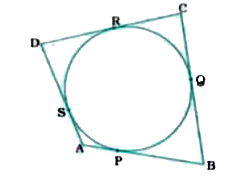A quadrilateral ABCD is drawn to circumscribe a circle (see the given figure). Prove that AB+CD = AD+BC.
 Solution in Gujrati
Solution in Gujrati
The correct Answer is:AB+CD=AD+BC
Step by step video, text & image solution for A quadrilateral ABCD is drawn to circumscribe a circle (see the given figure). Prove that AB+CD = AD+BC. by Maths experts to help you in doubts & scoring excellent marks in Class 10 exams.
Updated on:21/07/2023Topper's Solved these Questions
- CIRCLEBOOK - KUMAR PRAKASHANCHAPTER - CIRCLEEXERCISE - Objective Questions (Fill in the blanks)
5 Videos
- CIRCLEBOOK - KUMAR PRAKASHANCHAPTER - CIRCLEEXERCISE - Objective Questions
10 Videos
- CIRCLEBOOK - KUMAR PRAKASHANCHAPTER - CIRCLEEXERCISE - Exercise 10.1
7 Videos
- ARITHMETIC PROGRESSIONBOOK - KUMAR PRAKASHANCHAPTER - ARITHMETIC PROGRESSIONEXERCISE - OBJECTIVE QUESTIONS
1 Videos
- CONSTRUCTIONS BOOK - KUMAR PRAKASHANCHAPTER - CONSTRUCTIONS EXERCISE - OBJECTIVE QUESTIONS
25 Videos
Similar Questions
From a point Q. the lent of tangent to a circle is 24cm and the distance of Q from the centre is 25cm. The radius of the circle is……..
View SolutionPQ is tangent drawn from point P to a circle with centre O and QR is a diameter of the circle, such that ∠POR=120∘. Then, ∠OPQ=……...
View SolutionHow many tangent can a circle have ?
View SolutionAnswer each question by selecting the proper alternative from those given below each question so as to make each statement true :
If the common difference of an AP is 5. then value of ,a18−a13 is .....
View SolutionTo draw a pair of tangents to a circle which are inclined to each other at an angle of 35°, it is required to draw tangents at the end points of two radii which are inclined to each other at an angle of ..........
View SolutionIn the given figure (not to scale), O is the centre of the circle. A,B,C and D are concyclic and AB=CD . If /_MON =120^(@) , then find /_ OPN .
View SolutionDetermine the point of symmetry of a regular hexagon.
View SolutionDtermine the images of the following figure about the given line :
View SolutionIn the figure above (not to scale), ¯¯¯¯¯¯AB⊥¯¯¯¯¯¯CDandAD is the bisector of ∠BAE.AB=3cm and AC=5cm. Find CD.
View SolutionMatch the following Column A to Column B

View SolutionMatch the following Column A to Column B

View SolutionMatch the following Column A to Column B

View SolutionFind the area of figure given below.

View SolutionFind the perimeter of the figure given below.

View SolutionFind the area of the figure given below.

View SolutionThe area of the shaded part in the figure given below is ______.

View Solution
